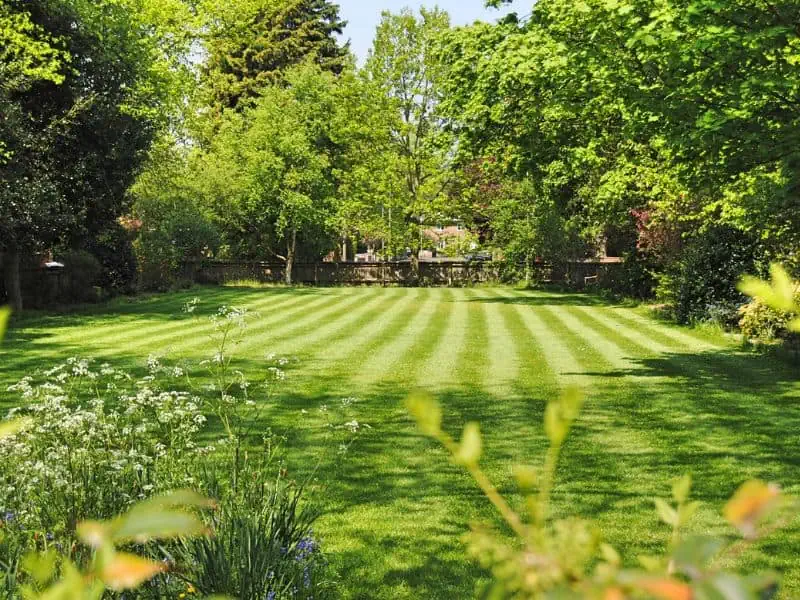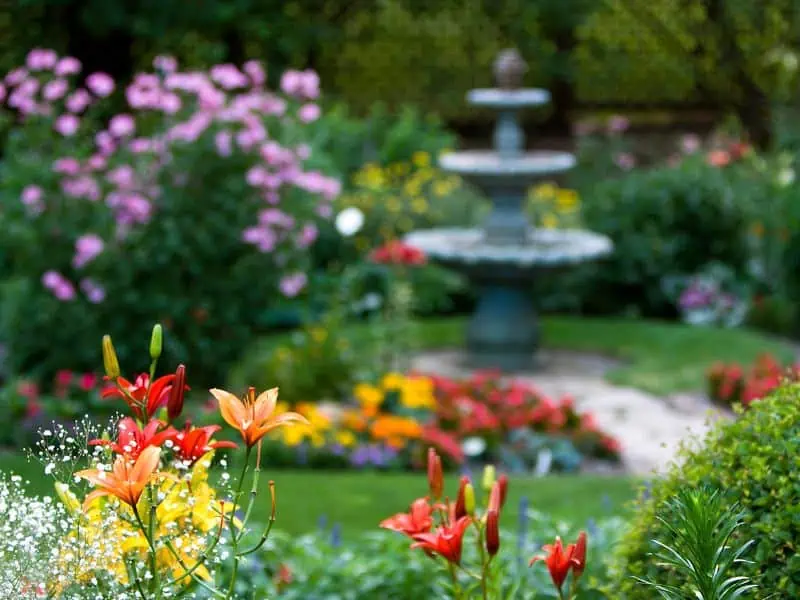A lush and vibrant lawn is the pride of any homeowner, but achieving and maintaining that perfect yard requires year-round attention and care. The good news is that by following a well-structured seasonal lawn maintenance calendar, you can ensure your lawn looks its best no matter the time of year.
Let’s break down the key tasks and tips for each season to help you achieve the beautiful yard you’ve always dreamed of.

Keeping Your Yard Beautiful All Year-Round
Spring: The Season of Renewal (March-May)
As the snow melts and the days grow longer, spring is the perfect time to kickstart your lawn care routine:
- Lawn Inspection: Start by assessing the condition of your lawn. Look for areas that may need reseeding, and take note of any disease or pest issues.
- Raking: Remove any leftover leaves, debris, and thatch that accumulated over the winter. This step not only improves the appearance of your lawn but also promotes air circulation and prevents disease.
- Aerate: If your soil is compacted after a long winter, aerating is essential. Aerating your lawn with a machine or specialized shoes allows water, air, and nutrients to penetrate the soil more effectively.
- Fertilize: Apply a balanced, slow-release fertilizer to give your grass the nutrients it needs for a healthy start to the growing season. Look for a fertilizer with a high nitrogen content, as this will encourage lush, green growth.
- Weed Control: Address weeds early before they can take over. Consider applying pre-emergent herbicides to prevent weed seeds from germinating.
- Seeding: If necessary, overseed thin areas of your lawn for a thicker, more lush appearance. Choose grass seeds that are well-suited to your region’s climate and soil type.
- Mowing: As the grass begins to grow, resume regular mowing. Set your mower blades to a height of about 2.5 to 3 inches, and avoid cutting more than one-third of the grass blade at a time.
The Benefits of Lawn Fertilization
Lawn fertilization in the spring not only promotes a vibrant and green appearance but also offers several other advantages. Fertilizers provide essential nutrients like nitrogen, phosphorus, and potassium that are crucial for plant growth.
These nutrients help your grass develop a robust root system, making it more resilient to environmental stressors such as drought, disease, and pests.

Additionally, a well-fertilized lawn contributes to improved soil health by enhancing microbial activity and nutrient availability.
If you find yourself hesitant to undertake the fertilization process on your own, you have the option to hire professional lawn fertilization services. Their expertise and meticulous care will ensure your lawn thrives, tending to it with the utmost precision, one blade at a time.
Summer: The Time for Vigilance (June-August)
Summer is when your lawn faces its most significant challenges, including heat and drought. Keep it healthy with these tasks:
- Watering: Deep and infrequent watering is key. Water in the early morning to reduce evaporation, and aim for about 1 to 1.5 inches of water per week. Invest in a sprinkler system or soaker hoses to ensure even coverage.
- Mowing: Continue to maintain a proper mowing height to encourage a healthy, drought-resistant lawn. Longer grass provides shade for the soil, reducing moisture loss.
- Fertilization: Apply a slow-release, nitrogen-rich fertilizer to sustain growth without excessive shoot growth. Be cautious not to over-fertilize, as this can lead to thatch buildup and lawn stress, or, as we mentioned earlier, opt for a fertilization service to take care of this task.
- Weed Management: Continue to address weeds as they appear. Hand-pulling and spot treatments can be effective and reduce the need for chemical herbicides.
- Pest Control: Monitor for lawn pests such as grubs, chinch bugs, and armyworms. Treat as necessary with appropriate insecticides or beneficial nematodes for eco-friendly pest control.
- Heat Stress: In areas with extreme heat, consider providing some shade for your lawn during the hottest part of the day. This can be achieved through strategically placed shade structures or by allowing trees to provide natural shade.

Fall: The Season of Preparation (September-November)
As temperatures cool down, your lawn prepares for winter. Help it recover from summer stress and strengthen for the coming cold:
- Aerate: Fall is an excellent time for core aeration to improve soil health. Aeration reduces compaction, enhances root growth, and allows for better water absorption.
- Fertilize: Apply a fall fertilizer with a higher potassium content to promote root development and winter hardiness. This will help your lawn endure cold temperatures and bounce back vigorously in the spring.
- Raking: Keep leaves and debris off the lawn to prevent suffocation and disease. If the leaves are not too thick, you can use a lawn mower to mulch them and leave them on the lawn.
- Overseeding: Repair thin spots with cool-season grass seed for a fuller lawn next year. Overseeding in the fall allows new grass to establish itself before winter.
- Winterizing: Adjust your mower blade to its highest setting for the final cut of the season. A taller grass height going into winter helps protect the crown of the grass and improves its resilience.
Winter: Minimal Maintenance (December-February)
Winter lawn care is minimal, but there are a few tasks to consider:
- Snow Removal: Keep your lawn clear of heavy snow to prevent compaction and damage. Avoid piling snow on your grass for extended periods.
- Avoid Foot Traffic: Stay off the frozen lawn to prevent damage to grass blades. Walking on a frozen lawn can lead to unsightly brown patches in the spring.
- Plan for Spring: Use this time to plan for any lawn improvements you want to make in the upcoming spring. Research new lawn care techniques, tools, or landscaping ideas to enhance your yard’s beauty.
Final Thoughts
Your yard is much more than just a patch of grass; it’s an actual extension of your home, a place where memories are made, and a sanctuary for relaxation. Maintaining a beautiful yard is not just about aesthetics; it’s about creating an environment that enhances your quality of life and adds value to your property. A well-kept lawn provides a backdrop for outdoor activities, family gatherings, and moments of tranquility.

Throughout this year-round lawn maintenance calendar, we’ve explored the intricacies of nurturing and sustaining a beautiful lawn, season by season.
Your lawn is a living ecosystem, and your year-round commitment to its care ensures that it thrives in all seasons. The effort you invest in spring, summer, fall, and even during the quieter winter months pays off in the form of a lush, healthy lawn that stands out in your neighborhood.
So, roll up your sleeves, step out into your yard, and let the journey to a beautiful lawn begin. Happy gardening!